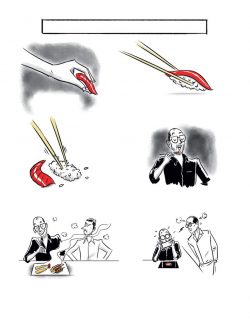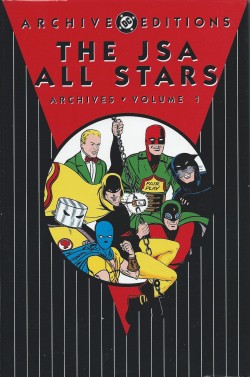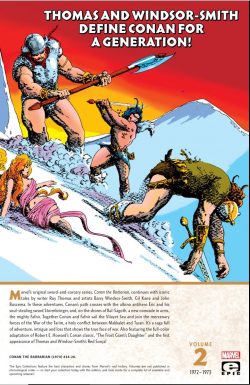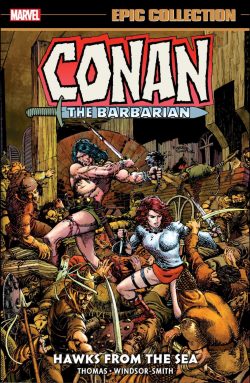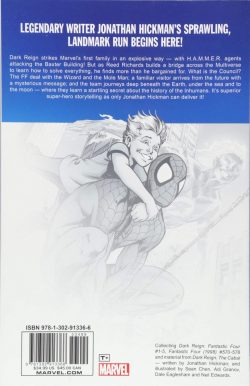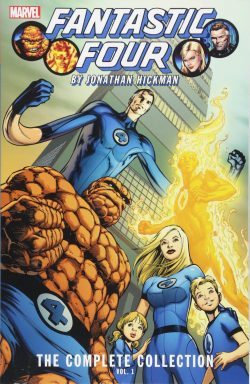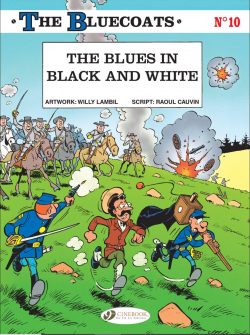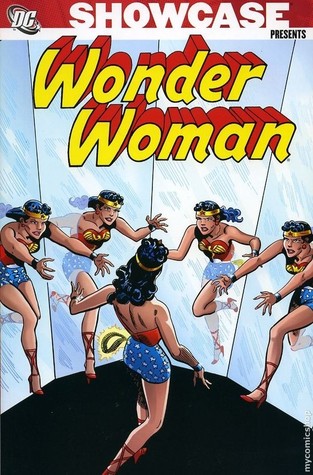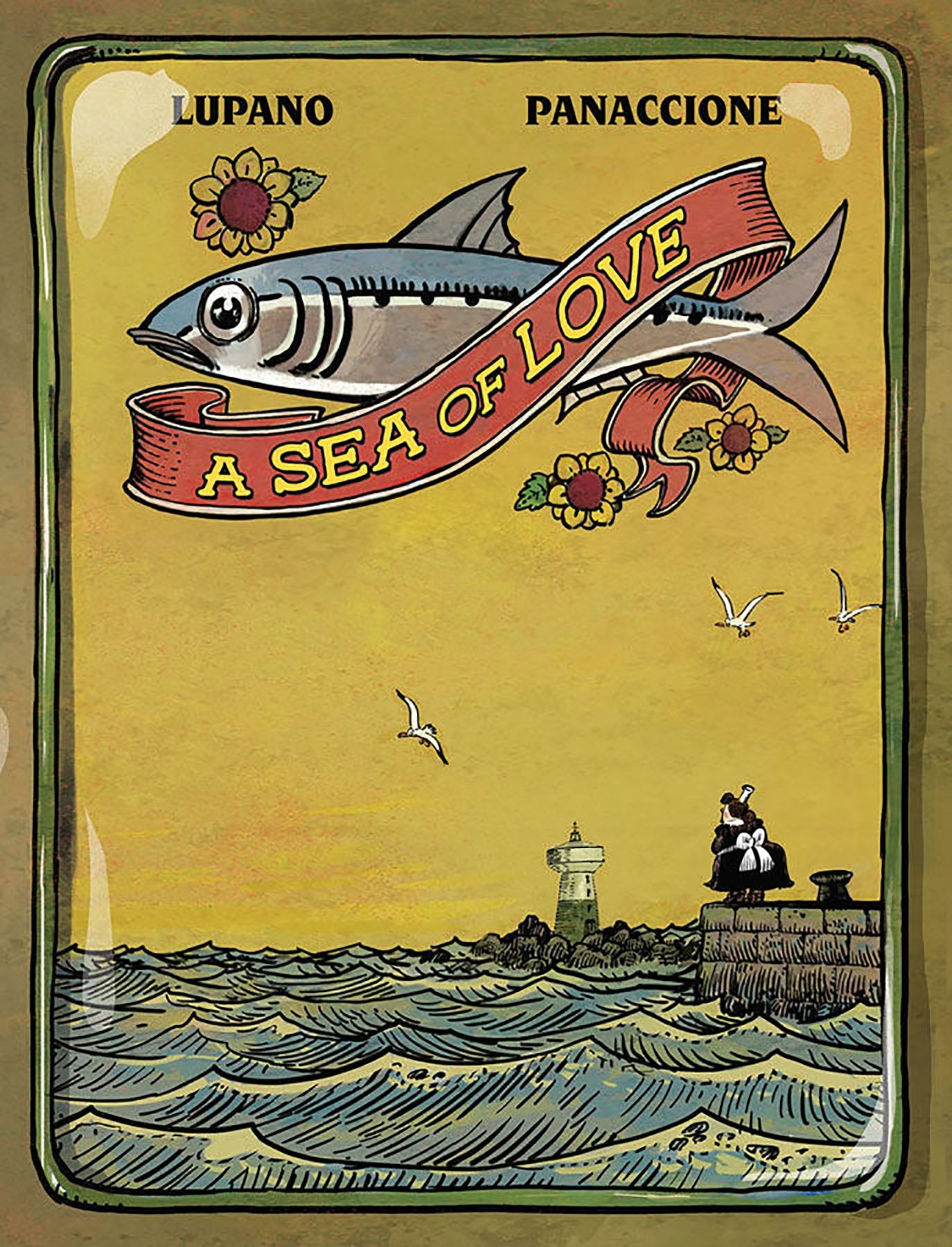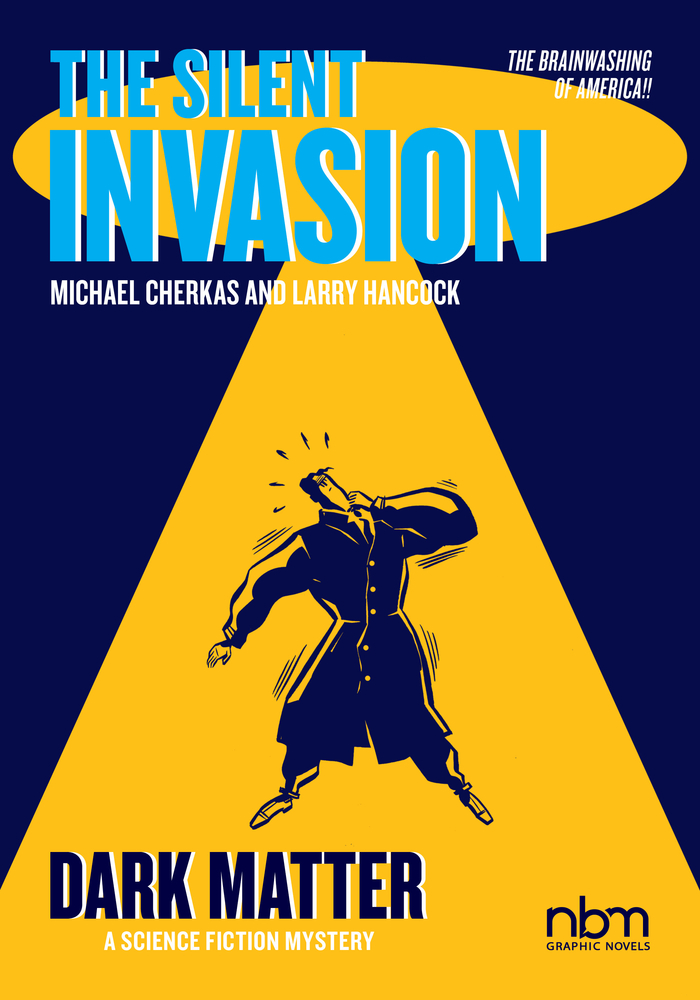
By Michael Cherkas & Larry Hancock (NBM)
ISBN: 978-1-68112-283-0 (TPB) eISBN 978-1-68112-284-7
Win’s Christmas Gift Recommendation: Sinister, Seductive, Superb… 10/10
During the vast expansion of opportunity and outpouring of innovation that graced comics during the 1980s, much of the “brain-rotting trash†or “silly kid’s stuff†stigma which had plagued the medium was finally dispelled. America started catching up to the rest of the world; acknowledging sequential narrative as an actual Capital “A†Art Form, and their doors opened wide open for foreigners to make a few waves too…
One of the era’s most critically acclaimed and inescapably intoxicating features sprang from semi-Canadian outfit Renegade Press which set up shop in the USA at the start of the black & white comics bubble in 1984. They quickly established a reputation for excellence offering a strong line of creator-based properties including some genuinely remarkable series such as Ms. Tree, Journey: The Adventures of Wolverine MacAlistaire, Flaming Carrot, Normalman, and a compulsively backwards-looking Cold War/UFO/paranoia-driven delight: The Silent Invasion.
That last was a stunningly stylish conspiracy saga, bolting 1950s domestic terrors (invasion by Reds; invasion by aliens; invasion by new ideas…) onto Film Noir chic: and employing 20-20 hindsight to produce a phenomenally fresh and enticing delight for the strangely similar Reagan era. From here and now, it’s never seemed more distressingly likely that politics, if not all history, is cursed to repeat certain cycles and strategies…
The series was eventually collected as four superbly oversized monochrome tomes, re-presenting the lead story from the first dozen issues of The Silent Invasion wherein inspired co-creators Michael Cherkas & Larry Hancock designed a delightful confection combining all the coolest genre elements of classic cult sci-fi, horror, spy, conspiracy theory, crime, romance and even comedy yarns…
Now, as the world again teeters on the edge of a multiple-choice test of imminent dooms – and with America once more enduring internecine struggle amongst the citizenry, corruption, cover-ups at every level of government and the press under attack from the people and traditions it seeks to inform and safeguard – the series is remastered, revised, re-released and continued in a handy trade paperback size (or fully adjustable eBook format)…
Gripping and utterly addictive, The Silent Invasion is incomprehensibly charming and challenging. Rendered in a compelling, spectacularly expressionistic style it is an epic of perpetual twists and turns, leaving readers dazed, dazzled and always hungry for more, and its Machiavellian contortions and observations have never been more relevant than now. After all, doesn’t the news confirm every day that infiltration is complete, assimilation is near-total and utterly non-human tyrant-morons have already co-opted earthly corridors of power…
1950s America remains a hugely iconic and paradoxical time. Incomparable scientific and cultural advancements, great wealth and desperate, intoxicating optimism inexplicably arose amidst an atmosphere of immense social, cultural, racial, sexual and political repression with an increasingly paranoid populace seeing conspiracy and subversive attacks in every shadow and corner of the rest of the world.
Such an insular melting pot couldn’t help but be fertile soil for imaginative outsiders to craft incisive, evocative tales dripping with convoluted mystery and taut tension, especially when wedded to the nation’s fantastic – and then-ongoing – obsessions with rogue science, flying saucers, gangsterism and espionage…
They were also obsessed with hot babes and bust sizes, but that’s not really a mystery, is it?
What Has Gone Before: In April 1952, infamous Union City private eye Dick Mallet saw a strange light in the night sky. Next morning, cops found his empty, crashed automobile. A month later reporter Matt Sinkage was still getting grief from Frank Costello, Editor of the Union City Sentinel. Matt was frantic to expose “The Truth behind Flying Saucers†but became an ostracised laughing stock, especially since he also suspected his foreign-sounding neighbour Ivan Kalashnikov was a Russian spy….
Sinkage alienated his family and drove his fiancée Peggy Black to distraction. All he could think about was the night six months ago in Albany when he witnessed a UFO and impetuously chased after it: a crazy night everyone remembers… except him.
When Matt broke into Ivan’s apartment, he saw the foreigner and others in front of a huge, weird machine. It confirmed his suspicions that they were Atomic spies. Days later, Matt collided with Mr K’s pretty friend Gloria Amber and cunningly asked her out to lunch. Things developed and Gloria begged him to save her from what she claimed were Red agents, even though the thugs subsequently claimed to be Federal agents…
Hiding out at his brother Walter‘s place, Matt was still seeing flying saucers everywhere and couldn’t understand why everybody else thought they were just jets. In Union City, Costello was pressured by brutish FBI Agent Phil Housley: an old acquaintance who regularly forced him to suppress unwelcome or troubling news items…
This time he wanted Sinkage. What no newsman knew was that Housley also worked for a shadow agency: The Council. What Housley didn’t know was that he was only a pawn…
Back in suburbia, Walter’s wife Katie – convinced Matt and his new floozy Gloria were up to no good – reached out to the FBI. The fugitives were heading out in Walter’s car when Peggy showed up. She couldn’t understand why her man was with a flashy trollop, and wouldn’t accept that Matt only wanted the lowdown on the Reds and access to Kalashnikov’s memoirs and files. Matt knew Gloria was playing a double game, but agreed to go with to a remote town where a “contact†could protect them both. Mr K called in his own heavies to hunt them, all factions equally unaware the FBI had visited Katie and a net was closing around Sinkage and his mystery woman…
When the Council learn Sinkage was involved in the “Albany eventâ€, near-panic ensued. Matt eventually succumbed to suspicion. Gloria kept vanishing and refused to acknowledge it and Kalashnikov’s hoods Zanini and Koldst abducted her and roughed up Matt.
Events spiralled and came to a head in sleepy distant Stubbinsville. Housley and the FBI tracked the runaways, meeting up with the Reds and what might well have been aliens in the isolated region. The net closed around them as a fantastic, terrifying light-show ignited the dark skies. By the time the G-Men reached them, Gloria had vanished and Sinkage was in a coma. Days later, he was free and all charges dropped. He was strangely content. Despite another blatant cover-up and no clue as to whom all the various parties hounding them really were, Sinkage knew what he had seen when Gloria vanished. Now he could only wait for her inevitable return…
Three years later, in September 1955, he was still waiting. He’d spent much of that time in an asylum. On release, he moved to bucolic Rockhaven and resumed his old trade as a journalist. The uncaring outsider had tentatively established himself in the small town, but his job at The Ranger paid a pittance and offered no satisfaction. Sinkage earned extra cash writing fake news for spurious tabloid The Tattler.
His life spiralled again after a proposed piece on cattle mutilations led to a quasi-religious space cult in his own backyard. At first journalistic sight, the Sirian Utopia Foundation was a long con gulling wealthy widow Gladys Tanner. She devoutly believed the world was heading for imminent Armageddon and that her new gurus were in contact with a benign cosmic council promising enlightenment and global paradise, and could reunite her with her departed husband…
Her followers included prominent Washington politicians who Sinkage connected to missing scientists. When Housley turned up, acting friendly, Matt lapsed into old suspicions and started snooping, “discovering†a fake flying saucer in the Tanner barn was a prop disguising the real thing…
The Council’s top thug Brennan resurfaced, spouting drivel about commie conspiracy at the Tanner farm but again, drastic action by the Feds ended the investigation convincing Sinkage that America and the world are in the midst of a sly alien conquest only he can expose.
Sinkage joined his nemesis as part of Housley Investigations in Union City, even though it meant moving living with Walter and despicable Katie. By May 1958, he was a phantom celebrity: a flying saucer freak regularly cited by the media, yet seldom seen. Cassandra-like, he warned of invasion, and stalked Presidential hopeful Senator Harrison T. Callahan – a candidate he believed to be a mind-controlled alien puppet.
By 1959, he was an anonymous star on TV, stridently declaring how aliens seized minds. When Senator Callahan sought to stifle Sinkage’s campaign, The Council reactivated Housley, claiming the entire alien issue a Soviet plot to destabilise America. Over Walter’s objections Katie manoeuvred to get Sinkage back into the asylum and he subsequently vanished from their lives…
In August, Callahan officially announced his candidacy and Sinkage made a desperate move, resolved to save humanity whatever the cost…
He was foiled by Housley who briefly became a minor celebrity, but by 1965 the grizzled world-weary Private Eye was old news. Nobody cared anymore how he saved the life of America’s next president in August or that he killed a crazy reporter. Housley’s life was all about making ends meet, accommodating estranged wife Vivian while still seeing his kids, and keeping secretary/girlfriend Meredith Baxter happy. Union City, meanwhile, reeled from a string of bizarre serial killings…
With life constantly kicking him hard, Phil found an unexpected upside after predatory, exceedingly generous client Sarah Finster hired him to find her husband, Howard. He was an attorney at prestigious Phelps, Finster and Phelan: a simple, uncomplicated guy who started suffering blackouts, He’d been disappearing for days at a time and reappearing with no knowledge of where he’d been or that time has passed. That truly intrigued Housley, since he’d been experiencing exactly the same problems lately…
Diligent investigation led Phil to a shrink named Jeffrey Plunck, and more than he bargained for. Apparently, Howard had been disappearing and experiencing memory problems for a year, and claimed he’d been abducted by aliens…
Officious Dr. Plunck stonewalled in a manner Phil thought only Feds could pull off, and for some reason Housley had a chilling dream about Matt Sinkage. When an envelope arrived, containing a note and recent photo of Plunck and the impossibly still-alive Sinkage, Phil sought out Nora Marsh: Howard’s girl on the side and another regular alien abductee. Abruptly ambushed, he regained consciousness to find Nora gone, leaving a list of names that led him to Howard. When he took the bewildered lawyer home, Housley was blasted by blazing light and awakened having lost more time and memories…
Revisiting all he knows about Sinkage and confronting the reporter’s former boss Frank Costello, Housley learned Nora’s list is people who have recently died or been murdered in uncanny circumstances. Walter Sinkage then added fuel to the insane alien nonsense by expounding a raft of crazy suppositions about Canada’s Flying Saucer programme – and their football exploits – which left the weary detective more baffled than ever and blithely unaware of how many different people have him under observation…
When bodies start piling up and circumstantially pointing to Phil, his increasingly troubled homelife and those oh-so-convenient memory black-outs only add fuel to a well-built fire of conspiracy, and as witnesses and potential allies vanish or die, a procedural net he was very used to holding closed around him.
Shifting into furious overdrive, Phil went on the run, determined to find answers. Raiding Plunck’s office, he stumbled upon an incredible nest of secrets, provoking a massive, deadly response which precipitated a savage clash with resurgent Council forces and the irresistible powers behind them…
The chilling campaign reaches 1970 in new volume Dark Matter, where (after ‘Previously in The Silent Invasion’ – a far more succinct précis of past events) dull and boring Walter Sinkage steps up to the paranoia plate after moving to suburban ‘Willowdale’.
Status-hungry wife Katie finally sees her life back on track, but the move proves her downfall as it causes Walter to look through brother Matt’s copious files, which have festered in the basement since before he died. It also overlaps the moment Walter experiences his first – but not last – flying saucer sighting…
Soon and inevitably, Walter is drawn into a beguiling web of intrigue and cautiously joins AAA – Alien Abductees Anonymous – run by creepily unctuous Reverend Wilson Monroe Parsons on behalf of the remarkably ubiquitous Xylotec Research Foundation. As “Steveâ€, Sinkage learns there are two kinds of abductee: the usual whacko attention-seekers and people like Charlene Bathgate – and himself – who have clearly been changed by something uncanny. Parsons can tell the difference and assigns Charlene to watch the new guy…
Home and work life deteriorate as Walter sinks further into obsession. Time and memories slip as the AAA crowd becomes his sole focus, and a tipping point comes when he’s introduced to gleaming and scary Pam and Sam, Missionary vanguards for the Cosmic Fellowship of Our Lady of the Spaceways temple (think Scientologists with even better teeth, and sparkles) who insist Steve has “the Gift†and give him their utmost attention. It translates into inviting themselves into Walter’s home and converting Katie into a braindead zealot. Events have meanwhile moved far beyond Walter’s control and he’s being dragged somewhere strange: seeing more lights in the sky and worse…
When he’s snatched by government-type heavies who want to take him to Stubbinsville, he’s saved by the miraculous appearance of Matt Sinkage before being drawn into the heavens for Enlightenment…
The Council return in a dominant position, executing plans that will reshape human society in ‘Camp X’ as Walter’s disappearance triggers a police missing persons investigation. For Detective Sawchuck it’s just another case, but his partner Eddy Dime is utterly overwhelmed by Walter/Matt’s files and irretrievably sucked in to the mystery. After talking to Reverend Parsons and Charlene, Dime cannot let go, especially after pressure from on high forces his boss to shelve the case…
Eddy doesn’t care. After finding Walter’s car in Stubbinsville and talking to town historian Sydney Ellsworth, he’s determined to examine a supposedly-decommissioned military base everyone knows is still active and the reason for so many UFO sightings. Ellsworth knows it’s just a lab for mind-control experiments by the Military-Industrial Complex that controls the government…
Whilst reporting to Katie Sinkage, Dime meets Pam and Sam, experiences headaches and disorientation and wakes up days later with jumbled memories. Refusing to drop the case he then realises he’s being watched by trench-coated strangers…
Enigma and intensity exponentially expand in ‘Feints and Fumbles’ as the web closes around Dime, who goes off the reservation, stashing Sinkage’s files. While Katie shills for the Cosmic Fellowship temple and predicts Walter’s imminent return, Charlene seemingly opens up to Dime: moving into his apartment to hide from the army of conspirators closing in. Soon after, Eddy sees lights in the sky and has his own inexplicable experience, and when Feds try to confiscate his findings, quits the force…
As the Council exerts its power over the police and city leaders, with many old faces like Dr. Plunck or Frank Costello in attendance, ‘Return to Stubbinsville’ finds Dime in business as a PI and finally face-to face with back-but-baffled Walter Sinkage. The abductee can’t remember much beyond probes and lights, but is convinced brother Matt was there. Hungry for answers, Dime enrols in the Cosmic Fellowship church and undergoes an orientation process that changes him forever, even as Charlene endures her own comeuppance. And then Ellsworth phones, urgently suggesting Dime come to Camp X if he wishes to achieve ‘Enlightenment’…
The truth might well be out there, but it’s not what anybody expects or is ready to accept…
Supplemented by a fascinating selection of ‘Sketches and Layouts’; riddled throughout with in-joke DC Comics creators Easter eggs, and contemporary critiques like a delicious swipe at a former President and legendary sore loser, this is another impeccable brush with mindboggling paranoia-as-entertainment you won’t be able to put down.
The Silent Invasion: Dark Matter provides an unforgettable gateway to an eerily familiar yet comfortably exotic era of innocent joy and a million “top secrets†no fan of fantastic thriller fiction should ignore – and the best is still to come…
© 2021 Michael Cherkas & Larry Hancock. All rights reserved.
The Silent Invasion: Dark Matter will be released on December 16th 2021 and is available digitally and for physical copy pre-order now.
Most NBM books are also available in digital formats. For more information and other great reads see http://www.nbmpub.com/

Christmas Treat: the entire saga thus far can be yours for a bargain festive price. Just head to…
THE SILENT INVASIONÂ Bundle (Includes VOLS. 1-4)
By Michael Cherkas & Larry Hancock

